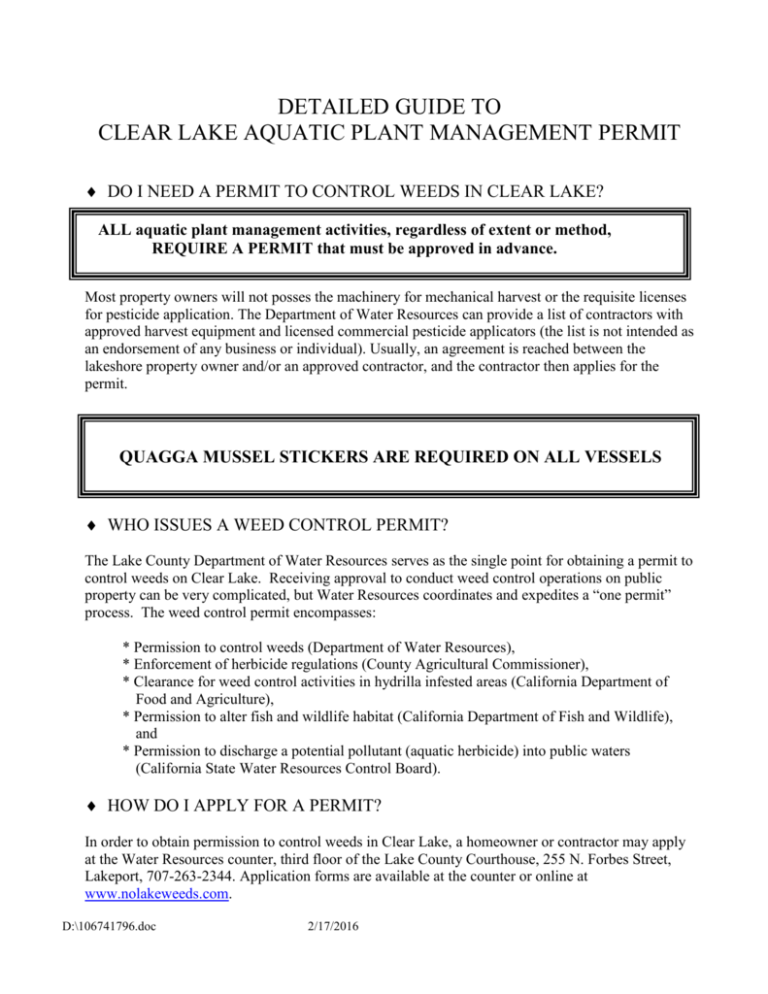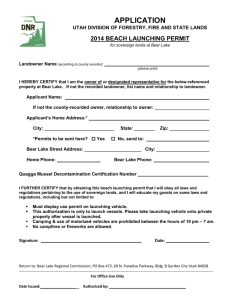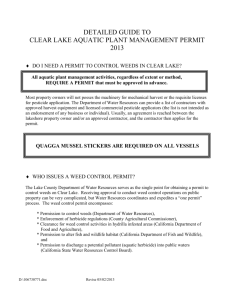Clear Lake Aquatic Weed Control Permit
advertisement

DETAILED GUIDE TO CLEAR LAKE AQUATIC PLANT MANAGEMENT PERMIT DO I NEED A PERMIT TO CONTROL WEEDS IN CLEAR LAKE? ALL aquatic plant management activities, regardless of extent or method, REQUIRE A PERMIT that must be approved in advance. Most property owners will not posses the machinery for mechanical harvest or the requisite licenses for pesticide application. The Department of Water Resources can provide a list of contractors with approved harvest equipment and licensed commercial pesticide applicators (the list is not intended as an endorsement of any business or individual). Usually, an agreement is reached between the lakeshore property owner and/or an approved contractor, and the contractor then applies for the permit. QUAGGA MUSSEL STICKERS ARE REQUIRED ON ALL VESSELS WHO ISSUES A WEED CONTROL PERMIT? The Lake County Department of Water Resources serves as the single point for obtaining a permit to control weeds on Clear Lake. Receiving approval to conduct weed control operations on public property can be very complicated, but Water Resources coordinates and expedites a “one permit” process. The weed control permit encompasses: * Permission to control weeds (Department of Water Resources), * Enforcement of herbicide regulations (County Agricultural Commissioner), * Clearance for weed control activities in hydrilla infested areas (California Department of Food and Agriculture), * Permission to alter fish and wildlife habitat (California Department of Fish and Wildlife), and * Permission to discharge a potential pollutant (aquatic herbicide) into public waters (California State Water Resources Control Board). HOW DO I APPLY FOR A PERMIT? In order to obtain permission to control weeds in Clear Lake, a homeowner or contractor may apply at the Water Resources counter, third floor of the Lake County Courthouse, 255 N. Forbes Street, Lakeport, 707-263-2344. Application forms are available at the counter or online at www.nolakeweeds.com. D:\106741796.doc 2/17/2016 PERMIT PROCESS All aquatic plant management activities, regardless of extent or method, must be approved in advance. The approval process is initiated by submission, in person, of a Clear Lake Aquatic Plant Management Permit Application to Water Resources (see How do I Apply). Valid applications must be accompanied by a Lakebed Map of the Shore of Clear Lake, scale 1”=50’, and/or an aerial photo of the site highlighting the treatment area. The complete application is processed and a copy is circulated to the CDFA Hydrilla Eradication field office and the Lake County Agricultural Commissioner’s Office for approval or denial based on their jurisdictional authority. The applicant will be notified within 48 hours when the application is ready for pickup. At pickup, applicant will sign the permit committing to compliance with all programmatic and specific conditions. At this time fees will be paid. HERBICIDES Administrative Controls. A greater degree of safety in the use of pesticides can be achieved by implementing rules which restrict who can recommend and use aquatic herbicides. These management practices include Federal Insecticide, Fungicide and Rodenticide Act (FIFRA) regulations concerning product registration and use labeling, state regulations governing applicator licensing, permits, and supplemental labeling for CA: A. All label directions will be followed. B. Applicators will operate under a valid ‘Operator ID Number’ issued by a County Agricultural Commissioner, and be registered in Lake County. C. Herbicides will be applied by licensed and registered Qualified Applicators (holders of current and valid Qualified Applicators License (QAL), or Qualified Applicators Certificate (QAC) with an Aquatic Pest Control Category, issued by the California Department of Pesticide Regulation (CDPR)) only. D. The commercial applicator shall make a site visit to verify the need for treatment, the suitability of the site for treatment, and the volume of water to be treated, prior to receiving a permit. The information collected at that time (weed species as a percentage of weed mass, growth stage, and area and depth to be managed) will help the applicator determine the method of control, the appropriate herbicide and amount of herbicide to apply. E. Immediately prior to treatment, the commercial applicator will examine a series of indicators and modify treatment plans accordingly. These indicators include (but are not limited to) heavy precipitation, recreational activity, boat traffic, water depth, water turbidity, and wind. If this examination indicates a potential for reduced control and/or increased water quality impacts, the treatment will be rescheduled. D.O. and temperature readings will be collected at 1 foot below the surface within the treatment area. D.O. levels below 5 ppm and/or temperatures above 80 ºF will act as thresholds that may prohibit herbicide applications or require an exception granted by the Invasive Species Program Coordinator. F. Chemical applications shall be cumulatively restricted to an area of no more than 30% of any individual parcel or ownership as measured between extensions of the parcel’s lot lines and lakeward from the shoreline for 300 feet. D:\106741796.doc 2/17/2016 G. A 16 foot wide boat lane out to open water to a distance of 300 feet from the shoreline can also be maintained. Approved Herbicides. Only those registered herbicides that have minimal spatial and temporal impact on beneficial uses will be considered for use in Clear Lake. Those include copper based herbicides, diquat, 2,4-D, endothall, glyphosate, imazamox, flumioxazin, fluridone, penoxsulam, sodium carbonate peroxyhydrate, and triclopyr . Notification. Even after all prudent and reasonable safety steps have been accomplished, some individuals feel at risk from herbicides. Making public notification of herbicide applications gives those individuals an opportunity to take the steps they feel are in their best interest. Prior to initial herbicide application, the individual applicators shall take steps to notify adjacent and/or potentially affected properties with respect to beneficial uses of treated water. The environmental hazard section on the label dictates the temporal and distance use restrictions. Data Collection and Reporting. The data collected by applicators are intended to support an adaptive management process to keep the Clear Lake Integrated Aquatic Plant Management Plan (APMP) current, and are a requirement of the County NPDES permit. A GIS database is used to manipulate the data for illustrative and decision-making purposes. This database will be updated to reflect the parcel or area receiving treatment. Reports shall be sent to the Invasive Species Program Coordinator, Lake County Water Resources, by the 15th of the month following application. Supplemental Pesticide Use Report (SPUR) Applicators will generate the SPUR to record the activities performed and the results of the treatment. The water temperature, D.O., and secchi depth shall be measured and recorded. The amount of herbicide applied, timing of treatment, and the area treated shall be measured and recorded. A follow-up evaluation and measurement of D.O. and temperature will be made at an interval of approximately one week when the greatest mass of dying vegetation might be expected, according to the herbicide employed in aquatic vegetation control. Species Present Report Applicators will generate a Species Present Report to record the aquatic plant species in the area to be treated and their relative percentage of plant biomass. These reports will be used by the applicator to confirm the appropriate chemical to be used and its method of application and rate. Enforcement/Quality Control. Applicators will be required to carry valid permit(s), including the Lake Bed Map or aerial photo with highlighted, permitted, treatment areas. Before leaving the site, the map must be updated to reflect the actual treatment area. Failure to truthfully and adequately complete reports could result in fines and the revoking of all outstanding permits. In compliance with NPDES permit requirements, lake-wide sampling for active ingredients will take place before and after the application season at the inflow and outflow of the lake. In addition, treatment sampling will occur for 10% of the permitted applications during the season for each active ingredient used. County staff shall perform water quality sampling with the cooperation of the applicator. D:\106741796.doc 2/17/2016 MECHANICAL/PHYSICAL CONTROL METHODS Cutting of aquatic weeds, by any method, increases the risk of spreading hydrilla, milfoil and other invasive species through fragmentation. For this reason, mechanical harvesting is prohibited within ¼ mile of sites where hydrilla is being actively managed and is discouraged in an area where milfoil is present. Coordination with the CDFA, Hydrilla Eradication personnel will be ongoing to ensure that county-permitted aquatic plant management will not interfere with their program. Any control program that results in fragmentation must include a method for the collection of plant fragments and disposal of fragments landward of the high water mark. Fragments must be prevented from reentry into any waterbody until fragments are unviable. The legal status of the Clear Lake hitch (Clear Lake’s endemic minnow) as a state endangered species now affords the hitch Endangered Species Act protections. Any mechanical harvesting of aquatic weeds must make every attempt to scare fish from the treatment area so that there is no likelihood of hitch being removed (taken) from the lake with the harvested vegetation. OTHER METHODS Applications for the use of Spot-Dredging, Weed Rolling, etc. will not be accepted at this time. Bottom barriers may be considered depending on their composition. PERMIT FEES Permits will be issued by the Water Resources upon review and approval of the appropriate agencies. Water Resources will notify applicants when the permit is available and must be picked up at the Water Resources office on the third floor of the Lake County Courthouse, 255 N. Forbes St., Lakeport, CA 95453. A Fee is due when the completed permit is picked-up by applicant. $ 100 per permit for herbicide treatments. $ 27 per permit for mechanical/physical cutting and/or pulling projects. The costs of the National Pollution Discharge Elimination System (NPDES) permit and associated monitoring and reporting is born by Lake County, and is not charged to the permit applicant. FURTHER INFORMATION The Lake County Department of Water Resources administers the ‘public lands’ of Clear Lake. It is necessary to seek official approval to spray or harvest weeds in Clear Lake because the waters of the lake constitute a public trust, and are not the private property of the lake shore land owner. Courts have established that lakeward of the low water line, Clear Lake is public property, and above that line, the water is considered part of a public easement. Considered waters of the United States, the lake was entrusted to the state of California. In 1973 administration of the lake was transferred by an act of the Legislature from the State Lands Commission to the County of Lake. Water Resources is responsible for the management of Clear Lake. D:\106741796.doc 2/17/2016 The County Agricultural Commissioner enforces laws concerning pesticide usage. This authority includes registration of various license and permit holders, worker protection, reporting of pesticide usage and inspection of activities related to pesticide use to ensure compliance with state and federal laws. The California Department of Food and Agriculture (CDFA) has been engaged on Clear Lake, since 1994, in an effort to eradicate hydrilla, a noxious and invasive aquatic weed. The eradication order is found in state law, and CDFA has broad authority over infested areas. While many public uses have been prohibited in other hydrilla infested water bodies in California, CDFA has been very cooperative with Lake County, allowing recreation to continue along side the eradication campaign. The California Department of Fish and Wildlife (CDFW) is responsible for protecting fish and wildlife habitat on public lands and public easements in the state. Since aquatic plants are important fish spawning and rearing habitat, consultation with CDFW with respect to weed management occurs each year with respect to the season’s start date for herbicide application. CDFW also enforces the Endangered Species Act (ESA) and is in contact with Water Resources with regard to the ESA protections placed on the Clear Lake hitch and the need for any further safeguards that might be needed. The State Water Resources Control Board enforces the federal Clean Water Act (CWA) in California. In March 2001 the federal courts declared that herbicide use in public waters requires compliance with the CWA. To meet that requirement, the County applied for a National Pollution Discharge Elimination System permit, which allows the use of state registered herbicides in Clear Lake. Any equipment that has been used in counties infested with aquatic noxious species, such as zebra/quagga mussels, must be physically inspected for invasive species or have been decontaminated or quarantined, before entering the waters of Clear Lake. For more information see www.nomussels.com. D:\106741796.doc 2/17/2016









